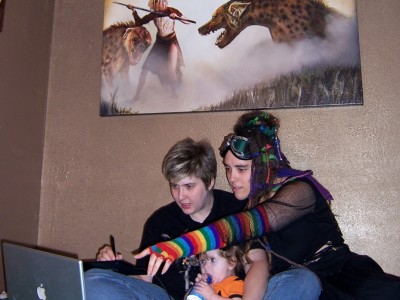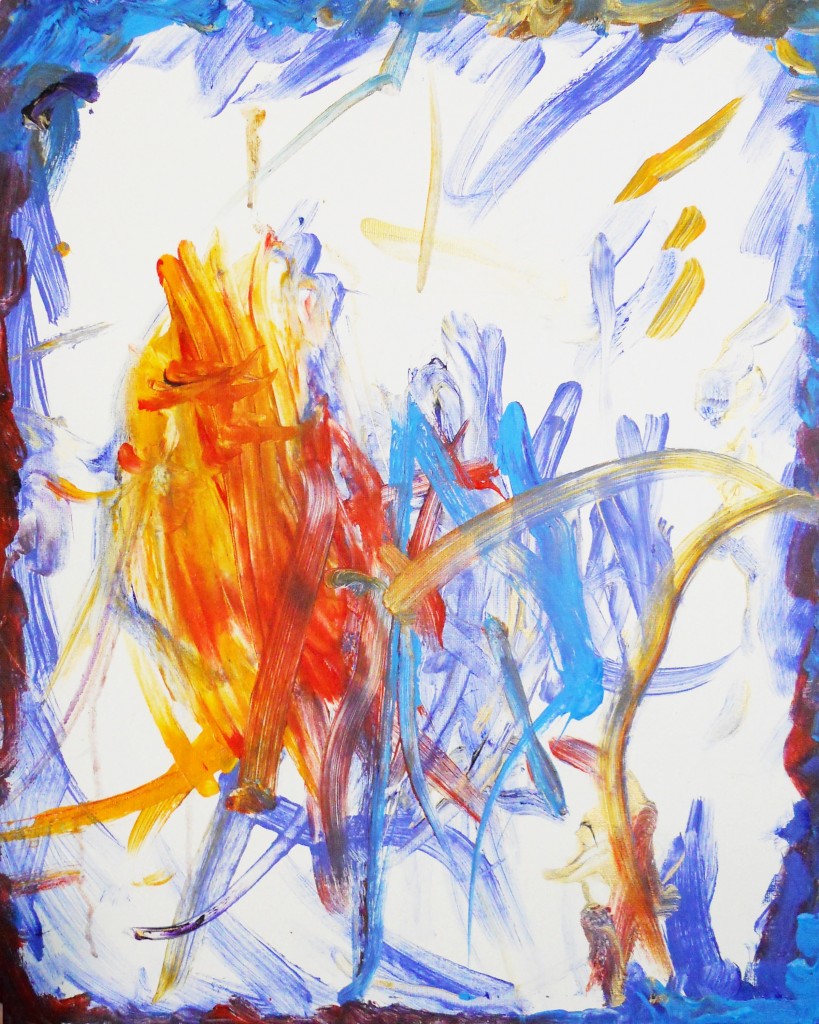What artistic media do you tend to favor in your work? For example, what did you use to create the cover image “The Washerwoman?”
MANDEM’s work is very much based in digital art. We’ve both been working with digital mediums since we were children; we are part of the first generation to have had digital paint as a plaything during childhood. Maize, in particular, has over 17 years of experience using digital paint. However, we’re increasingly engaging in an adulterous love affair with physical media, like oils and acrylics, so most of our recent work is what we call transdigital, moving seamlessly back and forth between physical and digital painting. For example, we might physically paint a background, scan it in, nearly complete the work as a digital painting (using the elements we created with physical paint), and finally finish the project with oils.
That said, “Washerwoman” is entirely digital. We think it’s one of those pieces where you can really see the degree to which physical media has influenced how we think about digital art; there’s an oil paint based aesthetic (particularly in the facial features), but the tiny detail work (such as the individual strands of hair and the buildings) would have been very difficult to achieve with physical media. We’ve had many experienced painters (including graduate-level MFA students and professors) absolutely convinced that “Washerwoman” was done with oils, possibly with highlights in acrylics, and that means we were successful in what we were trying to do aesthetically.
Your symbiotic process is intriguing. Can you describe it?
There’s a myth in Western culture of the impregnable Artistic Genius, creating art ex nihilo from his own spirit. The truth is, most artists do not create in a vacuum. The old masters had workshops full of apprentices and models and unacknowledged coworkers, and many modern artists, such as Damien Hirst, hardly even paint their own work but rather have their concepts executed by hired craftsmen. Even the most rugged individualist artists are often deeply indebted to a host of unacknowledged teachers, models, and family members who have supported their careers in invisible ways. When setting out to do art, MANDEM bucks that convention of imagining an unrooted genius and instead tries to acknowledge the ways in which art is always a mutual endeavor.
In terms of actual painting, physical brush on canvas (or stylus on tablet, as the case may be), the vast majority of the work is executed by Maize (with occasional creative highlights by the baby, Kitsuko). However, Moco is the ghost in the machine because she coordinates our models (or models herself), she helps to prepare canvases and make studio work go smoothly, she helps generate concepts and make important decisions on lighting, color choices, and even medium, and usually she stands by through the entire process giving creative input on artistic choices. Moco is also the one responsible for what we call the “proofreading” stage where she literally goes over the work with a magnifying glass and checks for any errors or minute inconsistencies. The relationship is a little as if Botticelli’s muse Simonetta had stripped off her fancy dresses, put on a smock, and come into the workshop to mix his paints and make composition choices.
Of course, recently, MANDEM’s long-time duo has been plus one, since little Kitsuko has increasing input on what she thinks should happen with the paintings.
Your daughter, Kitsuko, is so adorable. What has her artistic experience been like so far? What media does she like to work with, and what kind of art does she create?
Whenever we’re painting, Kitsu tries very hard to help (and yes, sometimes this is a little overwhelming). She’ll pick up dry brushes and “paint” on finished canvases for hours with her imaginary media. Because of her interest, we’ve started letting her actually help when putting on clear coats of varnish or gloss texture medium.
Since she was old enough to sit up, we’ve been giving her children’s finger paints and other art supplies made for kids—and now recently we’ve let her do her own artist-grade acrylic painting for the first time. She’s only 15 months old, so a lot of kids her age wouldn’t really know which end of the paint brush was which, but because she’s had so much experience watching us, she has a very strong idea of what she wants to accomplish when she approaches a canvas. She’s very vocal about choosing her own paint colors and she has very strong opinions about composition and color theory. She really likes complimentary colors—so she’ll paint with purple and metallic gold, or blue and orange, or red and green, with just hints of other colors. She likes to put a very concentrated, exuberant color section in the center and leave the rest of the canvas relatively untouched. As soon as she’s got her center done, she’ll throw the paintbrush down, throw her arms out, and say very decidedly, “Done!” Then clap for herself and walk away, and no matter what you do you can’t convince her to paint on it any more.
We also take her with us to most of our art openings, and we’ll walk around and look at all the paintings.
If she likes something, she’ll say, “That, that,” and sometimes clap. If she doesn’t like it, she’ll say, “Change it,” which is the same thing she says for dirty diapers and TV shows she doesn’t like, so then we have to go look at something else.
We can always tell if our work is coming along well if it’s a “that, that” piece.
She also really likes dancing and she’ll express her opinions and feelings in the form of dance whenever possible, and she lights up whenever she gets near a piano…we can’t wait to see what artistic paths she’ll chose to follow in her life.
What is “Mythpunk Art Noir?”
Maize has a Master’s Degree in Interdisciplinary Humanities, which is a polite way of saying that she was allowed to study whatever she wanted. Her focus, as an academic, has been on Critical Theory and how that relates to Classical Civilizations and on the ways that myths have been transmogrified through time.
We particularly take a queer approach to the history of mythology and when trying to answer the question “What genre is this? Is this fantasy art? Is this Steampunk? What are you doing here?” we only recently came to the loose description “Mythpunk Noir.” The -punk movements, such as cyberpunk and steampunk, have always been a huge influence on us (even before knowing the names for these movements) because they take technology and history and “queer” it (in the older sense of the word—and in some sense, the sexual sense of the word—they make it uncanny and unfamiliar). But in our own work, we really don’t limit ourselves to a technological or historical time period (such as cyber or steam). What really is our driving force is the -punk part.
Because of Maize’s background in Classics, most of our material references or reinterprets folklore and mythology. For example, “Wallflower,” to us, has links to a cyberpunk version of the Minotaur myth. Likewise, the title for “Washerwoman” comes from a translation of an old British Isles myth about a fairy/hag creature who would wash the clothes of those who were about to die, so if you were going into battle you might see the Washer Woman in the stream washing your clothes—to us this tied in to the fall of industrialization as it connects to labor issues. Myths are a huge influence on what we do. Another significant influence is what we call “The Golden Age of the Mythographers” in the late 1800s (that’s the Gilded Age, in America) and into the 1940s, because these European writings from the turn of the century completely reinvented how mythology is understood, and these writings coincided with and influenced the German Expressionist film movement that evolved into Film Noir. So, for us, there’s an inescapable link between visual Noir and the reinterpretation of mythology.
How do you think your Cleveland, Ohio roots have influenced your work? Is Cleveland possibly behind, or within, the Mythpunk Art Noir style you have developed?
Absolutely. Cleveland is the hearth/home of our art in many ways. The almost post-apocalyptic feel of huge segments of Downtown Cleveland (where we used to live) has impacted how we think about the world. You can see that in “Washerwoman” and “A Light in the Distance” (which are two images from the same non-existent landscape). Cleveland is magical. There are all these beautiful old houses from the Gilded Age—the millionaires at the time built mansions in the heart of East Cleveland, then abandoned them later as “urban blight” struck and so, unlike some urban areas that are architecturally impoverished, in East Cleveland slums look like a Victorian apocalypse took place. When we lived there, we owned a 19th-century funeral parlor that had been gutted out and served as a crack house before we bought it. We paid less than $20,000 for it (this was before the market crashed—it recently sold for about $3000) because it was said to be haunted and no one wanted it. One time, we were riding home on the bus in the middle of the night and about to get off in our neighborhood, and a homeless man warned us not to get off the bus there because the neighborhood is haunted: there are witches and wolves and an old funeral home with ghosts in it. We did not tell him that we lived there and the “wolf” was our pet (a husky hybrid)…. but it was all wonderful and terrible and we’d like to go back some day.
How is it for you to be an artistic presence in Tallahassee—exhibiting there, and making connections?
Tallahassee is a remarkably artistic town for how small it is. We have two large universities, and a really thriving little art district called Railroad Square. We’ve been a a bit taken aback by how excited people are about our work here. We’re definitely not a “Florida Artist”—we don’t do palm trees or gators (…usually), yet our work has been selected to display in Tallahasse City Hall and the university library, and other public places. Perhaps some of our more recent pieces have a touch of Florida sunshine in the way the golds come out—you can see that in “Washerwoman.”
Maize was just accepted into Florida State’s studio art MFA program, which we’re very excited about because neither of us have had any formal artistic training before this year. Maize is especially looking forward to a chance to work with Carrie Ann Baade, who is one of our generation’s foremost Visionary/Surrealist artists.
You have a couple of exhibitions outside the U.S. this year. What is your fan base like—who, and where, are they?
At this point, I believe our fanbase is living in the Internet. We of course have fans in America, and the UK, Germany, and other parts of the world, but the way our work is spreading is mostly online through a variety of social communities that transcend physical borders. For example, we have been nominated for a number of prominent steampunk art awards; that community has really embraced our work and steampunk is absolutely a transnational phenomenon. We also have a lot of fans in other subcultural music or art movements, like darkwave. More recently, we’ve started having a lot of shows in our new hometown of Tallahassee, but that’s only been going on within the past year. Honestly it’s still a surprising experience for us when Tallahassee locals talk about having seen and enjoyed our work, even though we’ve never been the least bit surprised when someone from another continent has emailed us a fan letter.




